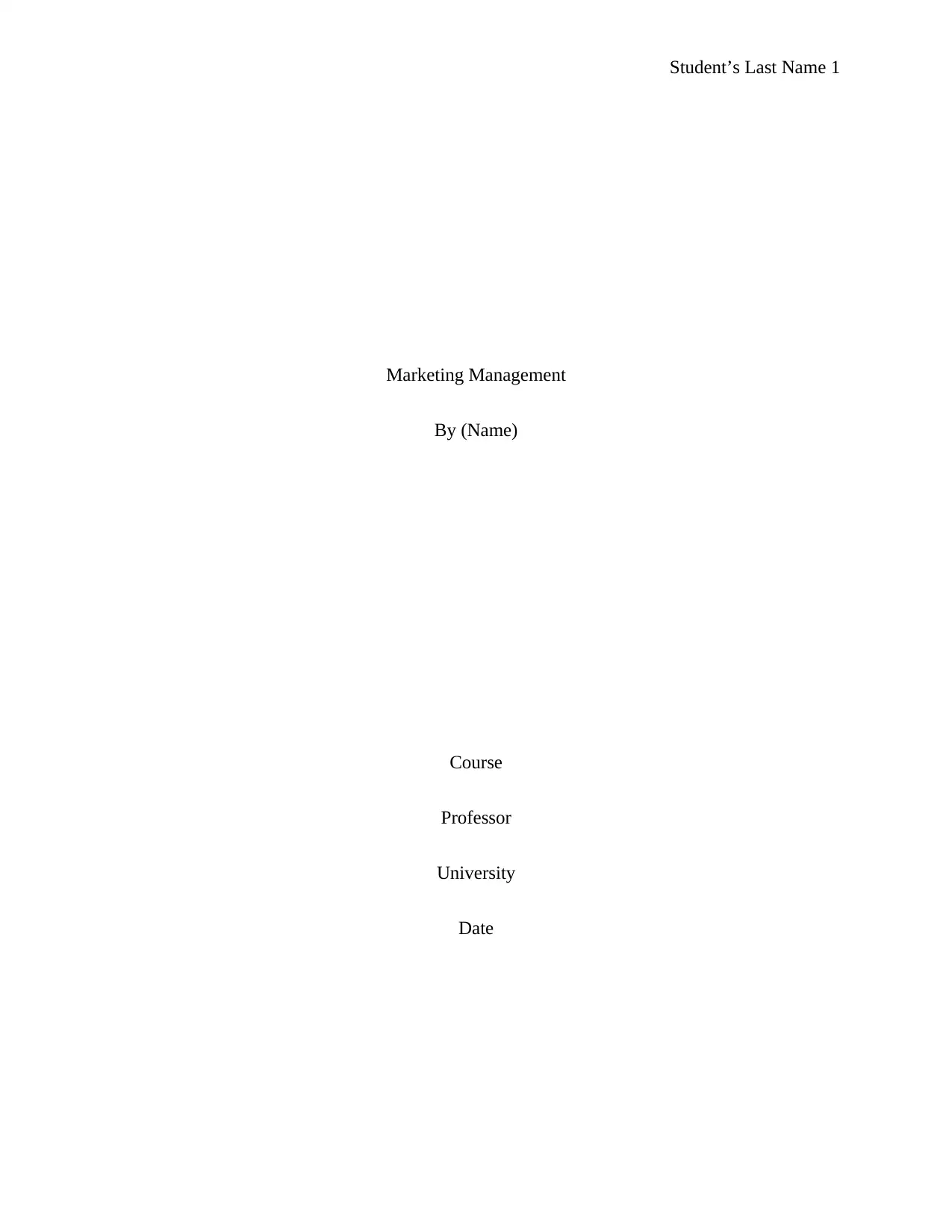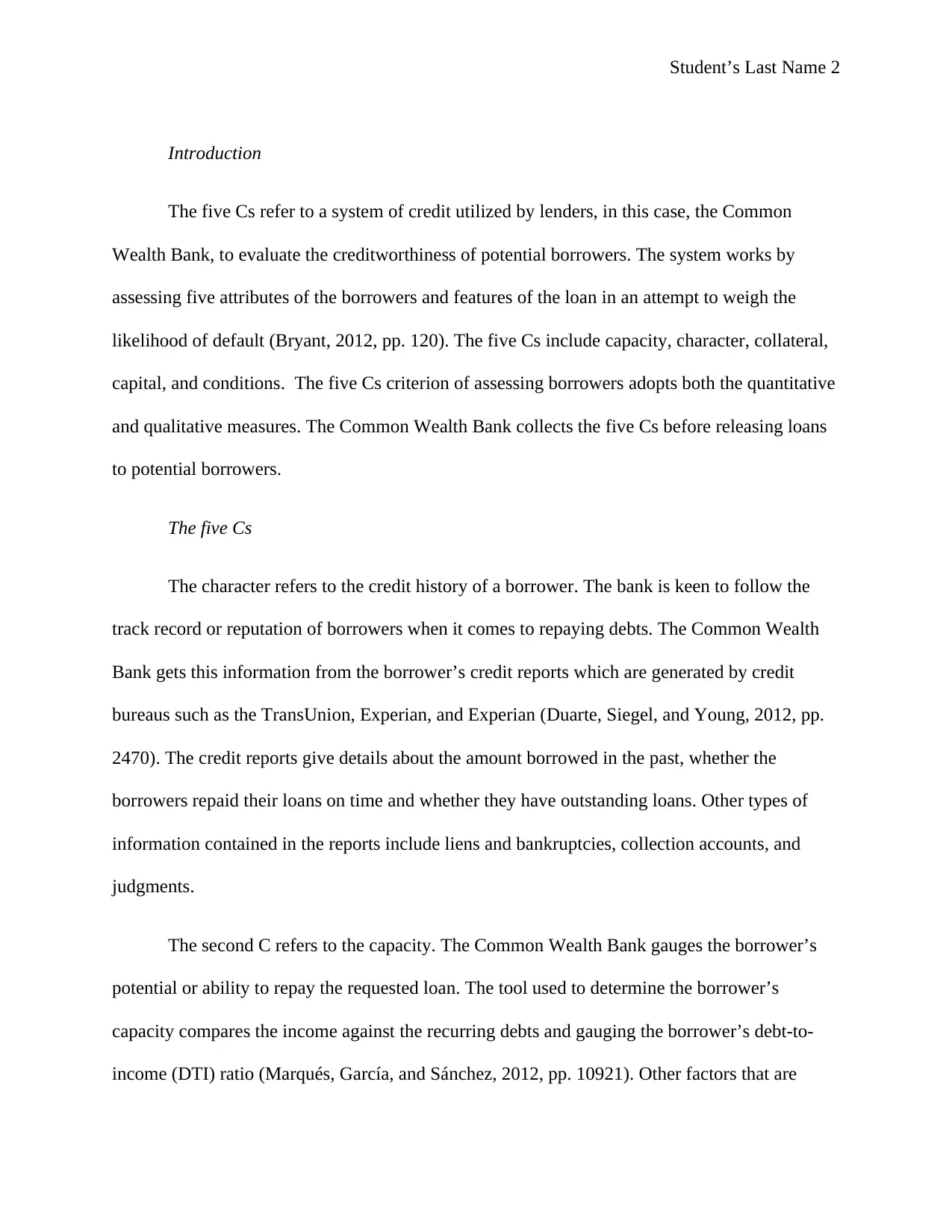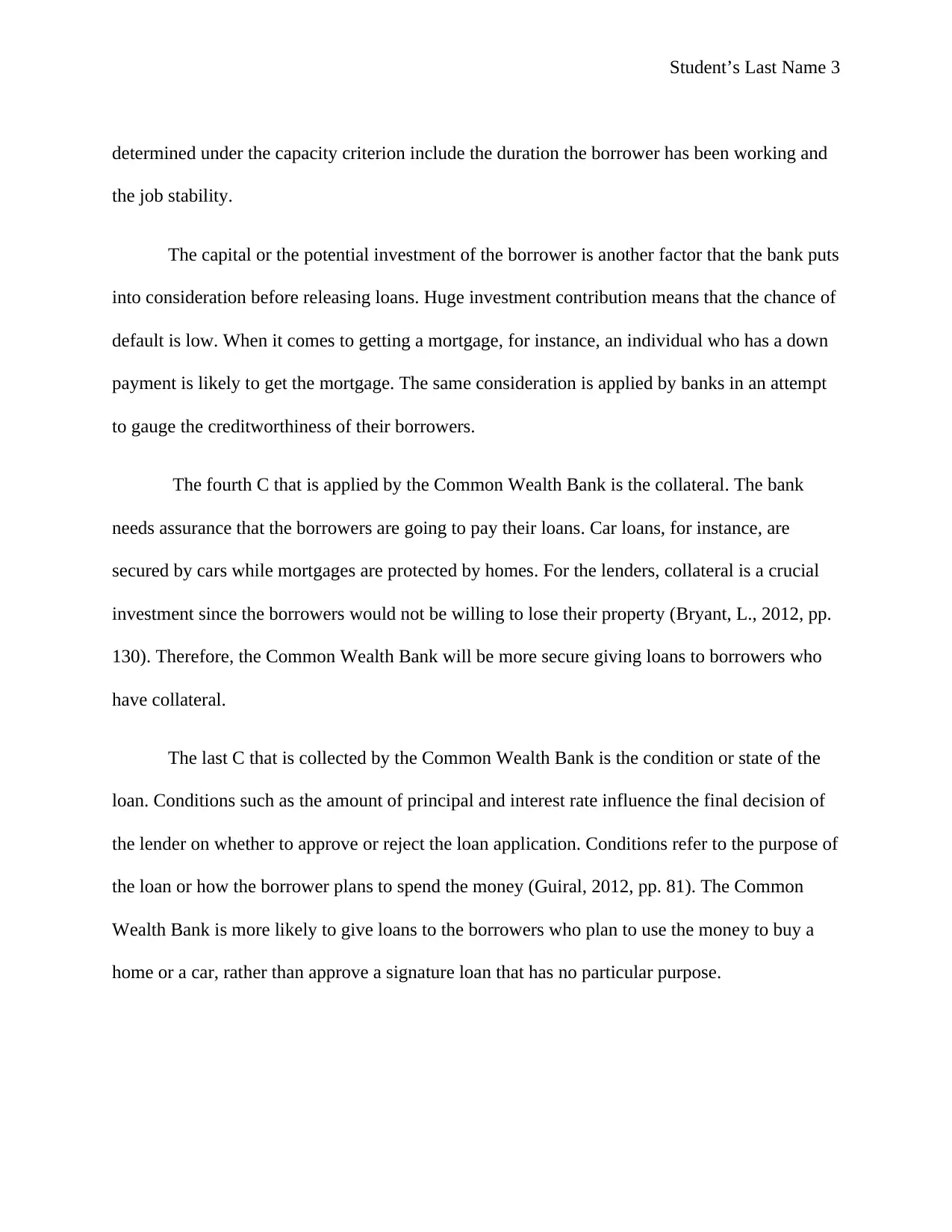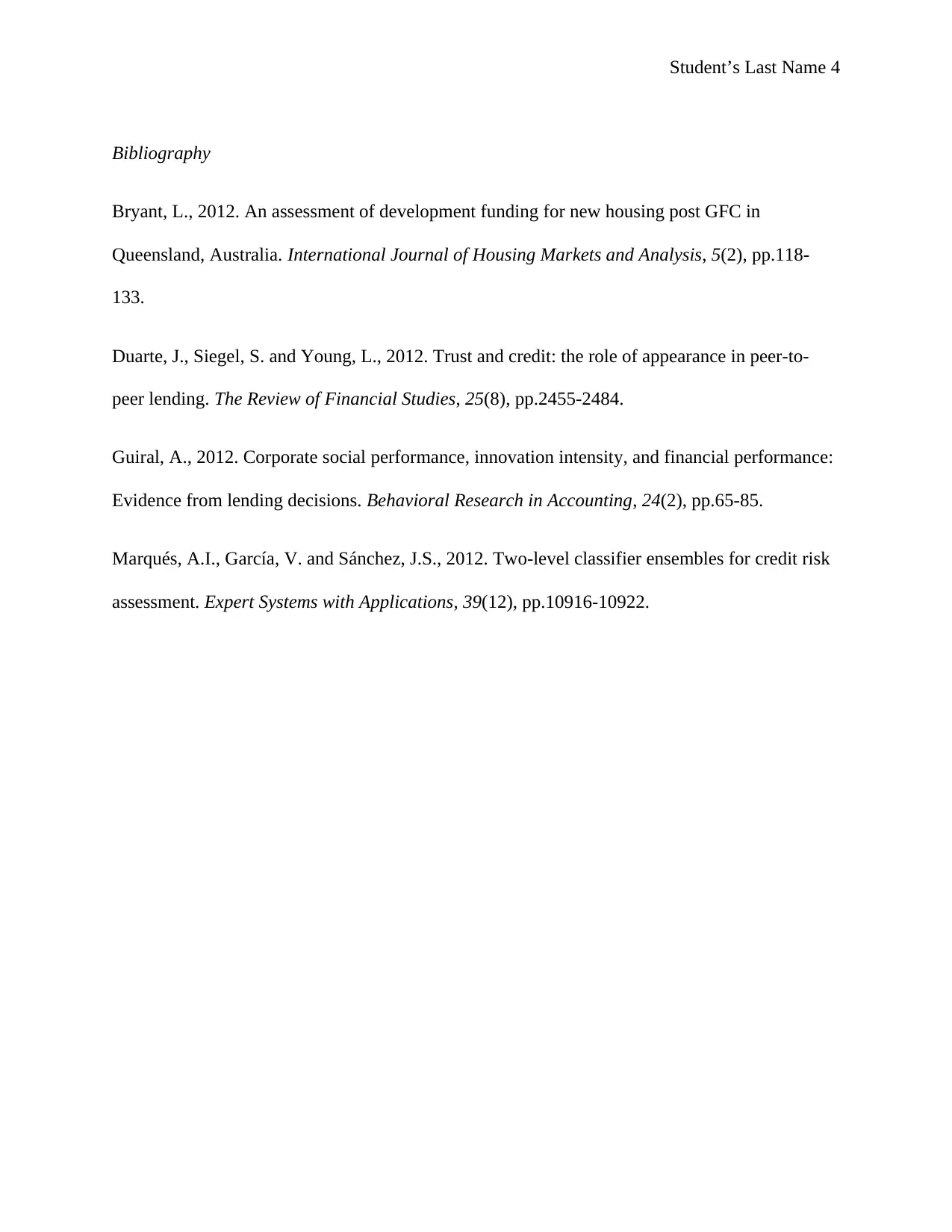Credit Analysis: An Overview of the Five Cs for Lending Decisions
VerifiedAdded on 2020/04/01
|4
|772
|30
Report
AI Summary
This report analyzes the Five Cs of credit, a system used by lenders like the Commonwealth Bank to assess the creditworthiness of potential borrowers. The framework evaluates five key aspects: character, capacity, capital, collateral, and conditions. Character focuses on the borrower's credit history, while capacity assesses their ability to repay the loan based on income and debt. Capital considers the borrower's investment in the project, and collateral provides security for the loan. Finally, conditions examine the loan's purpose and terms. The report explains how the bank collects and applies these factors to determine the likelihood of loan repayment, drawing on sources to support its analysis.

Student’s Last Name 1
Marketing Management
By (Name)
Course
Professor
University
Date
Marketing Management
By (Name)
Course
Professor
University
Date
Paraphrase This Document
Need a fresh take? Get an instant paraphrase of this document with our AI Paraphraser

Student’s Last Name 2
Introduction
The five Cs refer to a system of credit utilized by lenders, in this case, the Common
Wealth Bank, to evaluate the creditworthiness of potential borrowers. The system works by
assessing five attributes of the borrowers and features of the loan in an attempt to weigh the
likelihood of default (Bryant, 2012, pp. 120). The five Cs include capacity, character, collateral,
capital, and conditions. The five Cs criterion of assessing borrowers adopts both the quantitative
and qualitative measures. The Common Wealth Bank collects the five Cs before releasing loans
to potential borrowers.
The five Cs
The character refers to the credit history of a borrower. The bank is keen to follow the
track record or reputation of borrowers when it comes to repaying debts. The Common Wealth
Bank gets this information from the borrower’s credit reports which are generated by credit
bureaus such as the TransUnion, Experian, and Experian (Duarte, Siegel, and Young, 2012, pp.
2470). The credit reports give details about the amount borrowed in the past, whether the
borrowers repaid their loans on time and whether they have outstanding loans. Other types of
information contained in the reports include liens and bankruptcies, collection accounts, and
judgments.
The second C refers to the capacity. The Common Wealth Bank gauges the borrower’s
potential or ability to repay the requested loan. The tool used to determine the borrower’s
capacity compares the income against the recurring debts and gauging the borrower’s debt-to-
income (DTI) ratio (Marqués, García, and Sánchez, 2012, pp. 10921). Other factors that are
Introduction
The five Cs refer to a system of credit utilized by lenders, in this case, the Common
Wealth Bank, to evaluate the creditworthiness of potential borrowers. The system works by
assessing five attributes of the borrowers and features of the loan in an attempt to weigh the
likelihood of default (Bryant, 2012, pp. 120). The five Cs include capacity, character, collateral,
capital, and conditions. The five Cs criterion of assessing borrowers adopts both the quantitative
and qualitative measures. The Common Wealth Bank collects the five Cs before releasing loans
to potential borrowers.
The five Cs
The character refers to the credit history of a borrower. The bank is keen to follow the
track record or reputation of borrowers when it comes to repaying debts. The Common Wealth
Bank gets this information from the borrower’s credit reports which are generated by credit
bureaus such as the TransUnion, Experian, and Experian (Duarte, Siegel, and Young, 2012, pp.
2470). The credit reports give details about the amount borrowed in the past, whether the
borrowers repaid their loans on time and whether they have outstanding loans. Other types of
information contained in the reports include liens and bankruptcies, collection accounts, and
judgments.
The second C refers to the capacity. The Common Wealth Bank gauges the borrower’s
potential or ability to repay the requested loan. The tool used to determine the borrower’s
capacity compares the income against the recurring debts and gauging the borrower’s debt-to-
income (DTI) ratio (Marqués, García, and Sánchez, 2012, pp. 10921). Other factors that are

Student’s Last Name 3
determined under the capacity criterion include the duration the borrower has been working and
the job stability.
The capital or the potential investment of the borrower is another factor that the bank puts
into consideration before releasing loans. Huge investment contribution means that the chance of
default is low. When it comes to getting a mortgage, for instance, an individual who has a down
payment is likely to get the mortgage. The same consideration is applied by banks in an attempt
to gauge the creditworthiness of their borrowers.
The fourth C that is applied by the Common Wealth Bank is the collateral. The bank
needs assurance that the borrowers are going to pay their loans. Car loans, for instance, are
secured by cars while mortgages are protected by homes. For the lenders, collateral is a crucial
investment since the borrowers would not be willing to lose their property (Bryant, L., 2012, pp.
130). Therefore, the Common Wealth Bank will be more secure giving loans to borrowers who
have collateral.
The last C that is collected by the Common Wealth Bank is the condition or state of the
loan. Conditions such as the amount of principal and interest rate influence the final decision of
the lender on whether to approve or reject the loan application. Conditions refer to the purpose of
the loan or how the borrower plans to spend the money (Guiral, 2012, pp. 81). The Common
Wealth Bank is more likely to give loans to the borrowers who plan to use the money to buy a
home or a car, rather than approve a signature loan that has no particular purpose.
determined under the capacity criterion include the duration the borrower has been working and
the job stability.
The capital or the potential investment of the borrower is another factor that the bank puts
into consideration before releasing loans. Huge investment contribution means that the chance of
default is low. When it comes to getting a mortgage, for instance, an individual who has a down
payment is likely to get the mortgage. The same consideration is applied by banks in an attempt
to gauge the creditworthiness of their borrowers.
The fourth C that is applied by the Common Wealth Bank is the collateral. The bank
needs assurance that the borrowers are going to pay their loans. Car loans, for instance, are
secured by cars while mortgages are protected by homes. For the lenders, collateral is a crucial
investment since the borrowers would not be willing to lose their property (Bryant, L., 2012, pp.
130). Therefore, the Common Wealth Bank will be more secure giving loans to borrowers who
have collateral.
The last C that is collected by the Common Wealth Bank is the condition or state of the
loan. Conditions such as the amount of principal and interest rate influence the final decision of
the lender on whether to approve or reject the loan application. Conditions refer to the purpose of
the loan or how the borrower plans to spend the money (Guiral, 2012, pp. 81). The Common
Wealth Bank is more likely to give loans to the borrowers who plan to use the money to buy a
home or a car, rather than approve a signature loan that has no particular purpose.
⊘ This is a preview!⊘
Do you want full access?
Subscribe today to unlock all pages.

Trusted by 1+ million students worldwide

Student’s Last Name 4
Bibliography
Bryant, L., 2012. An assessment of development funding for new housing post GFC in
Queensland, Australia. International Journal of Housing Markets and Analysis, 5(2), pp.118-
133.
Duarte, J., Siegel, S. and Young, L., 2012. Trust and credit: the role of appearance in peer-to-
peer lending. The Review of Financial Studies, 25(8), pp.2455-2484.
Guiral, A., 2012. Corporate social performance, innovation intensity, and financial performance:
Evidence from lending decisions. Behavioral Research in Accounting, 24(2), pp.65-85.
Marqués, A.I., García, V. and Sánchez, J.S., 2012. Two-level classifier ensembles for credit risk
assessment. Expert Systems with Applications, 39(12), pp.10916-10922.
Bibliography
Bryant, L., 2012. An assessment of development funding for new housing post GFC in
Queensland, Australia. International Journal of Housing Markets and Analysis, 5(2), pp.118-
133.
Duarte, J., Siegel, S. and Young, L., 2012. Trust and credit: the role of appearance in peer-to-
peer lending. The Review of Financial Studies, 25(8), pp.2455-2484.
Guiral, A., 2012. Corporate social performance, innovation intensity, and financial performance:
Evidence from lending decisions. Behavioral Research in Accounting, 24(2), pp.65-85.
Marqués, A.I., García, V. and Sánchez, J.S., 2012. Two-level classifier ensembles for credit risk
assessment. Expert Systems with Applications, 39(12), pp.10916-10922.
1 out of 4
Related Documents
Your All-in-One AI-Powered Toolkit for Academic Success.
+13062052269
info@desklib.com
Available 24*7 on WhatsApp / Email
![[object Object]](/_next/static/media/star-bottom.7253800d.svg)
Unlock your academic potential
Copyright © 2020–2025 A2Z Services. All Rights Reserved. Developed and managed by ZUCOL.


